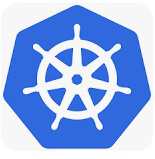| Kubernetes 1.34 Adds Dynamic Resource Allocation |
| Written by Kay Ewbank |
| Thursday, 02 October 2025 |
|
Kubernetes 1.34 has been released with improvements including distributed resource allocation support, and enhanced in-cluster traffic routing. Kubernetes is a portable, extensible, open source platform for managing containerized workloads and services, that facilitates both declarative configuration and automation.
Kubernetes provides service discovery and load balancing, so that if traffic to a container is high, Kubernetes can load balance and distribute the network traffic. It also provides storage orchestration, and will automatically mount a storage system of your choice, both local and cloud-based. Kubernetes also offers automated rollouts and rollbacks, and bin packing so you provide Kubernetes with a cluster of nodes that it can use to run containerized tasks and it will make the best use of your resources. As is traditional with Kubernetes, the release comes with its own name and release image. Titled "Of Wind & Will (O' WaW)", the developers describe this as "A release powered by the wind around us — and the will within us."
They say that every release cycle, we inherit winds that we don't really control — the state of our tooling, documentation, and the historical quirks of our project. Sometimes these winds fill our sails, sometimes they push us sideways or die down. In more specific terms, the improvements to the new release start with the general availability of a new way to handle Dynamic Resource Allocation (DRA). This gives users more ways to select, allocate, share, and configure GPUs, TPUs, NICs and other devices. While DRA has available in earlier versions, until now it has relied on using structured parameters that are opaque to the core of Kubernetes. The new version is more integrated with the heart of Kubernetes. A beta version of Projected ServiceAccount tokens for kubelet credential providers has been included in this version. The kubelet credential providers are used for pulling private container images, and until now relied on long-lived Secrets stored on the node or in the cluster. The Kubernetes team says this approach increased security risks. The kubelet can now request short-lived, audience-bound ServiceAccount tokens for authenticating to container registries. An alpha implementation has also been added of support for KYAML, a Kubernetes dialect of YAML. KYAML aims to be a safer and less ambiguous YAML subset, and was designed specifically for Kubernetes. The team says KYAML addresses specific challenges with both YAML and JSON, overcoming YAML's trickiness regarding whitespace, indentation and nesting, along with the way its optional string-quoting can lead to unexpected type coercion. Another useful addition improves the handling of streaming list responses. In previous versions, if a client requested extensive resource lists, such as thousands of Pods or Custom Resources, the API server was required to serialize the entire collection of objects into a single, large memory buffer before sending it. This created substantial memory pressure and could lead to performance degradation. A new streaming encoding mechanism for collections (list responses) has been introduced to overcome this problem. This should avoid large memory allocations on the API server, resulting in a much smaller and more predictable memory footprint. A full list of improvements is available on the Kubernetes website.
More InformationRelated ArticlesUltimate Guide to Kubernetes Pod Statuses JetBrains Improves Kubernetes Support In IDE Upgrades To be informed about new articles on I Programmer, sign up for our weekly newsletter, subscribe to the RSS feed and follow us on Twitter, Facebook or Linkedin.
Comments
or email your comment to: comments@i-programmer.info |
| Last Updated ( Thursday, 02 October 2025 ) |



